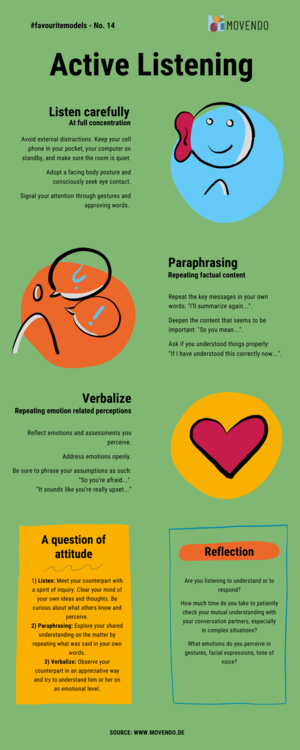#favouritemodels No. 14 - Active Listening

And how great it would be if this short, effective coordination were also possible every now and then during a meeting. For example, when I just tried to explain to my colleague how important it is to use our revised slide master with our new corporate design and logo in the current customer offer. Apparently I was heard and apparently they agree with me. Often it is only later - after days or even weeks - that it becomes clear that the person I am talking to has obviously heard or understood something else.
Active listening in everyday life - should be so easy, but the implementation is often difficult. Are you listening to me right now, or are you busy formulating your own thoughts? This question was once posed to me by one of my teaching coaches in coaching training. And indeed, I sometimes find myself focusing on thinking about what I could say or ask next when someone tells me something. Active listening, however, involves first clearing my head of my own ideas and thoughts and giving my counterpart my full attention. One could speak here of the spirit of research - an attitude with which I follow the ideas of the other person quite openly, curiously and free of my own agenda.
The second - often underestimated - step is paraphrasing. In other words, to make sure I have understood my counterpart correctly, I repeat what was said in my own words. "Did I understand correctly that the information about using the new slide master came too late?" "Yes, it was very late, and at the same time I didn't understand why it was so important to tackle everything again now, even though the offer was already finished in the old design."
This form of re-assurance provides for the fact that I can get to a common understanding on the factual level. Often, the understanding of the factual situation is even expanded, since paraphrasing quickly discovers when a detail is missing or misunderstood. Especially in complex situations, it is worth taking the time to check the understanding again and again together with the conversation partners, to summarize what has been discussed so far and thus to develop a shared mental map.
The third step in active listening is the so-called "verbalizing". Here, too, I summarize in my own words what I have understood. However, the focus is no longer on the factual level, but on the emotional level. As a listener, I am no longer so much interested in the WHAT, but in the HOW. How does my conversation partner express himself? What does the tone of voice sound like? How do I perceive gestures and facial expressions? What emotions are conveyed while my conversation partner is speaking? I put myself in the situation of my counterpart and try to understand him or her on an emotional level. For example, I could then reflect back: "It sounds as if you were frustrated because you had to revise the entire customer presentation at the last minute and you lost so much time...".
So active listening is much more than "just" listening in a mindful way. It also means establishing a genuine connection with my conversation partner so that the collaboration is characterized by mutual respect and trust.
The following tips can help you in your everyday life to listen actively:
How does my #favouritemodel help you?
Step 1: Listen attentively
- Try to avoid external "disturbing factors" from the outset. Leave your cell phone in your pocket, put your computer in standby mode, make sure the room is quiet.
- Consciously seek eye contact and adopt an open and facing posture.
- Also use gestures (nodding) or short words of agreement ("Hm", "Yes", "Ah") to signal that your attention is with the other person.
Step 2: Paraphrase
- Summarize the most important key statements in your own words (be careful not to repeat everything like a 'parrot').
- Deepen certain contents which seem to be important
- Ask questions and check whether you have understood things correctly or whether you have a common understanding of the situation.
- Possible formulations: "If I have understood you correctly now ..."; "Let me summarize again ..."; "So you mean ...".
Step 3: Verbalize
- Observe your counterpart in an appreciative manner and verbalize what you perceive.
- Reflect perceived or suspected emotions and evaluations. These will usually resonate in non-verbal behavior, i.e. in tone of voice, facial expressions and gestures.
- Speak openly about emotions - make sure to formulate your assumptions as such and not to present them as "truth" so that your counterpart has the opportunity to correct you at any time.
- Possible formulations: "So you fear ..."; "Could it be that you had hoped ..."; "It sounds as if you are really angry ...".











